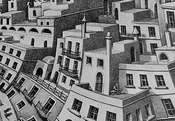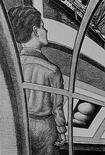| Hypercommunication - Crash Courses - Second-order Systems Theory [ Hyper-Library ] [ Hyper-Lexicon ] [ back ] |
|
|
backward - Page 8 - forward |
|
Since I make statements in the 2nd order about systems which concern me as an observer myself, I am in a kind of circularity when I talk about observer operations (note 1).
|
|
In the first order, I observe the world from the outside. So I observe - to remain in the expression of C. Escher's picture - in my environment - to which I myself do not belong tautologically, because it is around me as an environment - houses, ships, bridges, people etc. In this respect I am not interested that I observe, but in what I observe. In this respect I see a city, but I do not see that I see the city. The crowd of houses therefore appears to me as an object. I see my surrounding world as objectively existing. |
|

|
|
Of course, I can be aware that I am watching the world. I am not interested in what I see on the object level, but in the fact that the objects I see are objects of an observer. If I were not observing, I would not perceive objects. The city - and in C. Escher's picture - the image of the city in the gallery - is an object in the eyes of an observer. And when I observe an observer, he is - like any other object - an object in my eyes. In the second order I practically observe my own observations. I step out of the picture and take the perspective that I have opposite C. Escher's gallery as a viewer. The young man in the picture then appears to me, for example, as a self-portrait of C. Escher, which I can very well distinguish from the constructor of the picture. So I don't see a person seeing himself, but a picture of a person seeing himself. Above all, however, I also see the blind spot that is necessary for the person depicted to see himself in this way. As a picture viewer I see the blind spot in the picture, which the boy in the picture cannot see. I can see, as it were, how the supposed paradox comes about, because I see how it was constructed. |
|

|
In the 2nd order I observe the distinctions that underlie an observation. When I observe myself as a systems theoretician, I am interested in exploring the systems theoretical perspective in a self-referential way by observing the distinctions I use in systems theory. I thus apply the categorical concept of my systems theory self-referentially to myself as an observer. I see this as the best (most radical) critique of systems theory thinking. When I observe my distinctions, I naturally use distinctions again, which I can observe again. So with the 2nd order I start an endless recursion of self-referential observations. C. Escher's representation seems to me formally equivalent to this recursion, his blind spot doubles in itself as often as I like.
In the second order I describe myself by describing how I perceive my world. Thus, the self-representation in the 2nd order does not show beforehand how I appear from the outside, but which world I construct for myself, whereby I can naturally perceive myself as part of the world, as the boy in C. Escher's gallery can also see himself. In the second order I recognize myself by recognizing how I see the world. My world reflects my being (note 2). By reflection I understand that I get a picture of myself back, like when I look into a mirror. My statements about the world form a kind of hyper mirror, which does not show how the world really is, but how I perceive it. In an actual mirror or on a video I see more of myself than any external description can show me. And when I listen to what I say about the world, I see more of myself than in any mirror that only shows me my surface. So the 2nd order systems theory is for me a kind of tool for self-observation - even if I can overcome my blind spot as little as I can look into my own eyes.
Through the self-reference of the 2nd order systems theory I describe how I recognize myself as an observer through this theory. So it is not about the observer as such, but about understanding the implications of systems theory. In the aforementioned problem shift, I will thus experience what I represent in systems theory, not what I am as an observer.
[ ]|
|
backward - Page 8 - forward |